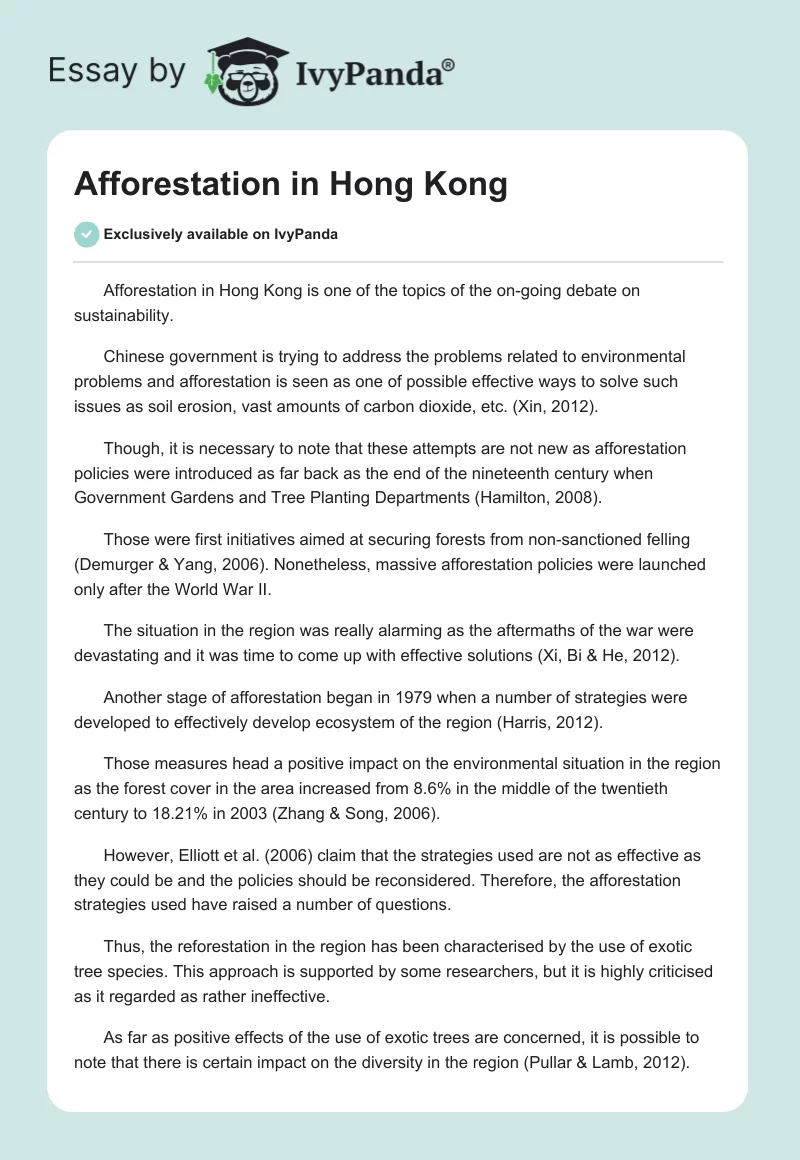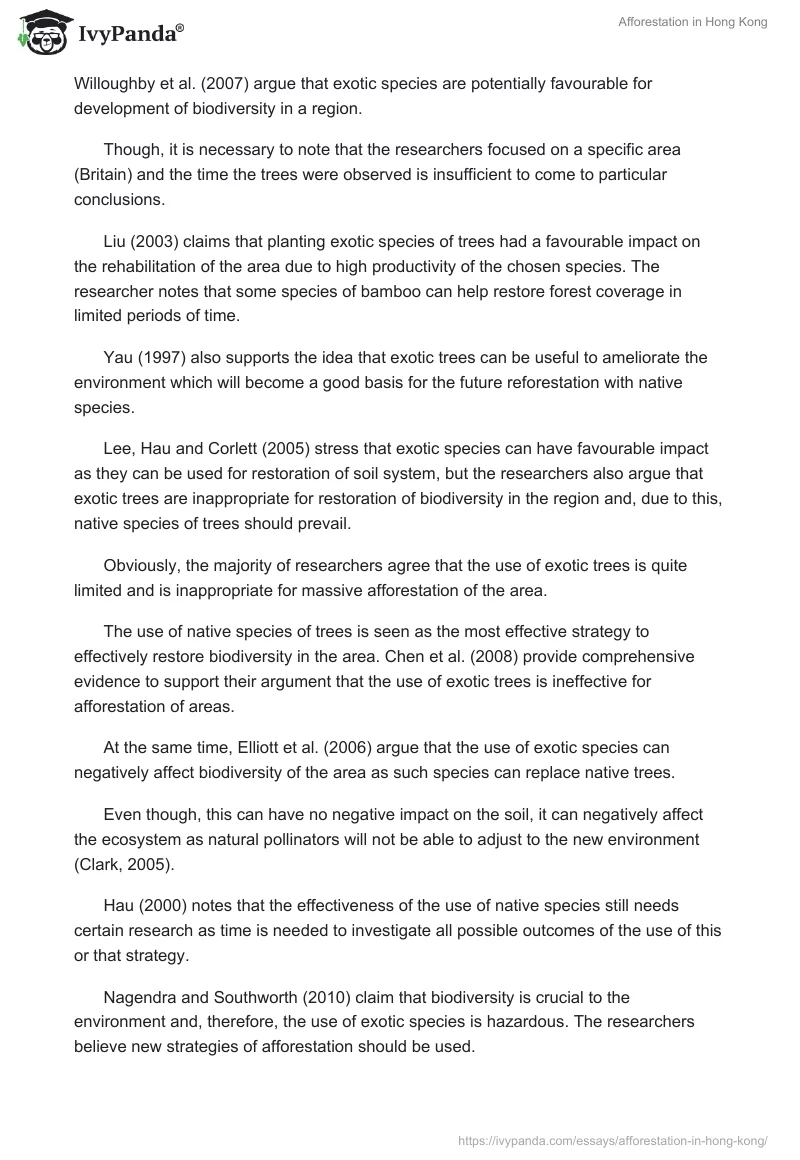Afforestation in Hong Kong is one of the topics of the on-going debate on sustainability.
Chinese government is trying to address the problems related to environmental problems and afforestation is seen as one of possible effective ways to solve such issues as soil erosion, vast amounts of carbon dioxide, etc. (Xin, 2012).
Though, it is necessary to note that these attempts are not new as afforestation policies were introduced as far back as the end of the nineteenth century when Government Gardens and Tree Planting Departments (Hamilton, 2008).
Those were first initiatives aimed at securing forests from non-sanctioned felling (Demurger & Yang, 2006). Nonetheless, massive afforestation policies were launched only after the World War II.
The situation in the region was really alarming as the aftermaths of the war were devastating and it was time to come up with effective solutions (Xi, Bi & He, 2012).
Another stage of afforestation began in 1979 when a number of strategies were developed to effectively develop ecosystem of the region (Harris, 2012).
Those measures head a positive impact on the environmental situation in the region as the forest cover in the area increased from 8.6% in the middle of the twentieth century to 18.21% in 2003 (Zhang & Song, 2006).
However, Elliott et al. (2006) claim that the strategies used are not as effective as they could be and the policies should be reconsidered. Therefore, the afforestation strategies used have raised a number of questions.
Thus, the reforestation in the region has been characterised by the use of exotic tree species. This approach is supported by some researchers, but it is highly criticised as it regarded as rather ineffective.
As far as positive effects of the use of exotic trees are concerned, it is possible to note that there is certain impact on the diversity in the region (Pullar & Lamb, 2012). Willoughby et al. (2007) argue that exotic species are potentially favourable for development of biodiversity in a region.
Though, it is necessary to note that the researchers focused on a specific area (Britain) and the time the trees were observed is insufficient to come to particular conclusions.
Liu (2003) claims that planting exotic species of trees had a favourable impact on the rehabilitation of the area due to high productivity of the chosen species. The researcher notes that some species of bamboo can help restore forest coverage in limited periods of time.
Yau (1997) also supports the idea that exotic trees can be useful to ameliorate the environment which will become a good basis for the future reforestation with native species.
Lee, Hau and Corlett (2005) stress that exotic species can have favourable impact as they can be used for restoration of soil system, but the researchers also argue that exotic trees are inappropriate for restoration of biodiversity in the region and, due to this, native species of trees should prevail.
Obviously, the majority of researchers agree that the use of exotic trees is quite limited and is inappropriate for massive afforestation of the area.
The use of native species of trees is seen as the most effective strategy to effectively restore biodiversity in the area. Chen et al. (2008) provide comprehensive evidence to support their argument that the use of exotic trees is ineffective for afforestation of areas.
At the same time, Elliott et al. (2006) argue that the use of exotic species can negatively affect biodiversity of the area as such species can replace native trees.
Even though, this can have no negative impact on the soil, it can negatively affect the ecosystem as natural pollinators will not be able to adjust to the new environment (Clark, 2005).
Hau (2000) notes that the effectiveness of the use of native species still needs certain research as time is needed to investigate all possible outcomes of the use of this or that strategy.
Nagendra and Southworth (2010) claim that biodiversity is crucial to the environment and, therefore, the use of exotic species is hazardous. The researchers believe new strategies of afforestation should be used.
In particular, the use of native trees should become the major strategy (Jim, 2012). Hau (2010) also stresses that native trees should be used to restore the ecosystem as the use of exotic trees can result in degradation of biodiversity in certain sites.
Therefore, it is clear that quite extensive research has been implemented on the matter.
The majority of researchers agree that the use of native trees is of paramount importance for the restoration of the biodiversity in the region and it should be the core strategy of the afforestation policies in Hong Kong.
Nonetheless, it is necessary to note that the experiments were carried out in quite limited periods of time. Admittedly, investigation of the development of ecosystems and biodiversity cannot be held within a decade.
Therefore, further research is essential. It is necessary to analyse the effectiveness of policies used in the middle of the twentieth century. It is also important to have a closer look at the exact species used in particular areas.
Reference List
Chen, L., Tam, N.F.Y., Huang, J., Zeng, X., Meng, X., Zhong, C., Wong, Y. & Lin, G. (2008). Comparison of ecophysiological characteristics between introduced and indigenous mangrove species in China. Estuarine, Coastal and Shelf Science, 79(1), 644-652.
Clark, J. (2005). Preserving Hong Kong’s Biodiversity. Web.
Demurger, S. & Yang, W. (2006). Economic changes and afforestation incentives in rural China. Environment and Development Economics, 11(5), 629–649.
Elliott, S., Blakesley, D., Maxwell, J. F., Doust, S., & Sutthathorn, S. (2006). How to plant a forest : The principles and practice of restoring tropical forest. Web.
Hamilton, S. (2008). Watching over Hong Kong: Private policing 1841-1941. Hong Kong: Hong Kong University Press.
Harris, P. G. (2012). Environmental policy and sustainable development in China. Bristol, UK: The Policy Press.
Hau, B. C. H. (2000). Promoting native tree species in land rehabilitation in Hong Kong, China. In S. Elliott, J. Kerby, D. Blakesley, K. Hardwick, K. Woods and V. Anusarnsunthorn (Eds), Forest restoration for wildlife conservation. (pp. 109-120). Thailand: Chiang Mai University.
Hau, B. C. H. & So, K. K. Y. (2003). Using native tree species to restore degraded hillsides in Hong Kong, China. Web.
Hau, B. C. H. (2010). Using native plant species in forest restoration and slope rehabilitation in Hong Kong, China. Web.
Jim, C. Y. (2012). Restoration of forests associated with new town development in Hong Kong. In J. Stanturf, D. Lamb, P. Madsen (Eds.), A goal-oriented approach to forest landscape restoration (pp. 129-149). London, UK: Springer.
Lee, E. W. S., Hau, B. C. H. & Corlett, R. T. (2005). Natural regeneration in exotic tree plantations in Hong Kong, China. Forest Ecology and Management, 212(1–3), 358–366.
Liu, D. (2003). Rehabilitation of degraded forests to improve livelihoods of poor farmers in South China. Bogor, Indonesia: CIFOR.
Nagendra, H. & Southworth, J. (2010). Reforesting landscapes: Linking pattern and process. Bloomington, USA: CIFOR.
Pullar, D. & Lamb, D. (2012). A tool comparing alternative forest landscape restoration scenarios. In J. Stanturf, D. Lamb, P. Madsen (Eds.), A goal-oriented approach to forest landscape restoration (pp. 129-149). London, UK: Springer.
Willoughby, I., Stokes, V., Poole, J., White, J. E. J. & Hodge, S. J. (2007). The potential of 44 native and non-native tree species for woodland creation on a range of contrasting sites in lowland Britain. Forestry, 80(5), 531–553.
Xi, W., Bi, H. & He, B. (2012). Forest landscape restoration in China. In J. Stanturf, D. Lamb, P. Madsen (Eds.), A goal-oriented approach to forest landscape restoration (pp. 65-93). London, UK: Springer.
Xin, Z. (2012). Afforestation to continue into next decade. The China Daily. Web.
Yau, F. (1997). Soil and afforestation in the Shing Mun Country Park, Hong Kong (Master’s Thesis. The University of Hong Kong, Hong Kong, China). Web.
Zhang, Y. & Song, C. (2006). Impacts of afforestation, deforestation, and reforestation on forest cover in China from 1949 to 2003. Journal of Forestry, 104(7), 383–387.


